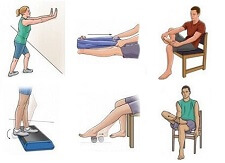- Home
- Foot Pain Symptoms
- Cramp
Foot Cramps
Written By: Chloe Wilson BSc(Hons) Physiotherapy
Reviewed By: FPE Medical Review Board
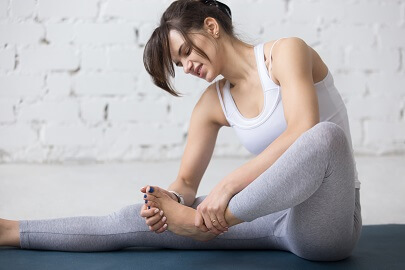
Foot cramps are caused by painful, intense, involuntary spasms of the muscles.
They are usually short-lived but can be really unpleasant and recovery can take a few days.
Foot cramps most commonly occur in the arch of the foot but people also complain of toe cramps and calf muscle cramps.
They are often caused by fatigue, reduced levels of certain chemicals, hormonal factors and illness. Cramping can occur any time day or night and are often associated with exercise. Anyone can get them but they become more common over the age of 80.
Here we will look at the symptoms, causes and treatment options for calf, toe and foot cramps.
Why Do We Get Foot Cramps?
To understand what causes toe, foot and calf muscle cramps, we need to know how muscles works. All muscles work in pairs – an agonist and antagonist.
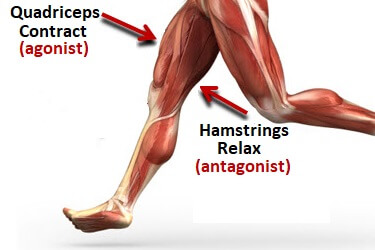
In order for them to work properly, as one muscle (agonist) contracts, the other (antagonist) relaxes to allow a smooth, controlled movement.
For example, when running, the quadriceps (agonist) contract while the hamstrings (antagonist) relax to extend the knee and bend the hip to swing the leg forwards to land.
If the antagonist muscle doesn’t relax properly, cramp develops. Alternatively, if a muscle contracts suddenly, with great force and then can’t relax, cramp can develop.
Leg cramping in the calves, feet or toes affect approximately one in four people over the age of sixty, increasing to one in three over the age of eighty.
What Does Cramp Feel Like?
Foot cramps are usually accompanied by sharp, intense pain and the muscle may feel “knotted”. It may be difficult to walk and bear weight through the affected foot.
Foot cramps are commonly associated with:
- Inner Foot Pain: particularly around the medial arch of the foot
- Bottom Of Foot Pain: along the plantar fascia
- Toe Pain: the toes often curl up and cross over each other
- Calf Pain: spasming in the gastrocnemius and soleus muscles on the back of the calf
Foot cramps may last for just a few seconds, or may continue on and off for a few days.
What Causes Cramps In Your Feet?
Foot cramps often have no obvious cause, but there are a number of factors that increase the risk of developing cramp:
1. Dehydration
Sweating reduces the levels of calcium, potassium and magnesium which can cause foot cramps. Smoking and excessive alcohol intake also increase the risk of dehydration.
2. Lack of Vitamins & Minerals
People often ask what deficiency causes foot cramps? The body needs the appropriate balance of vitamins and minerals to function properly. Foot cramps are commonly caused by imbalances in:

- Vitamin B6: is vital for healthy function of nerves and muscles
- Vitamin D: helps absorb calcium and magnesium. Getting at least fifteen minutes of sunlight a day helps prevent a lack of vitamin D
- Vitamin E: promotes good circulation and is needed for the production of red blood cells. Lack of vitamin E can therefore reduce oxygen levels to the muscles resulting in foot cramps
- Potassium: low potassium levels are known as hypokalemia and can be caused by excessive vomiting or sweating, kidney problems and medication
- Calcium: helps transmit nerve impulses to the muscle cells allowing the muscles to contract and relax normally. Excessive caffeine intake, lack of vitamin D and high sodium levels can reduce calcium levels
- Magnesium: lack of magnesium locks calcium and sodium ions into the muscle, preventing it from relaxing
3. Nerve Damage
Nerves transmit the signals from your brain to the muscles, telling them when to contract and relax. If a nerve is damaged e.g. pinched, signals cannot pass through properly correctly resulting in foot cramps. You can find out more in the foot nerve pain section.
4. Health Issues
Cramp may be a sign of an underlying health condition. Conditions such as Diabetes, thyroid problems, anaemia, Huntington’s Disease, Parkinson’s all increase the risk of foot cramps.
5. Medication

Some medications can cause cramping as a side effect in the legs or feet.
One of the most common medications causing foot cramps is Diuretics, commonly known as water pills. These increase urine production that can cause an imbalance of calcium and potassium, resulting in foot cramps.
6. Reduced Circulation
Long periods in the same position (e.g. sleeping) reduce circulation to foot. This reduces oxygen levels in the muscles leading to cramp.
7. Lack of Exercise
Not exercising regularly can result in muscle weakness and obesity, both of which increase the risk of cramp.
8. Muscle Tightness
Tightness in the calf muscles can cause calf cramps and tightness in the foot muscles, especially those running under the sole of the foot, can cause foot and toe cramps.
9. Fatigue
If you have been over-working your muscles, e.g. too intensely or for too long, or your body is generally fatigued, you are more likely to develop cramp. Athletes and dancers who place more stress on their feet are more prone to foot and toe cramps, runners are more prone to calf muscle cramps.
10. Pregnancy
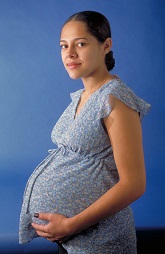
Foot cramps, especially at night, are common in the third trimester of pregnancy due to pressure from the uterus on the veins bringing blood up from the legs. This pressure reduces the circulation so fluid pools in the ankles and feet and increases the risk of foot cramps.
The best way to try and reduce foot cramps in pregnancy is to make sure you do some stretches before going to bed and try sleeping with a pillow between your legs to reduce the change of developing cramp.
11. Nocturnal Cramps
Foot cramps often develop at night due to decrease circulation from staying in one position and dehydration, most commonly in the calf muscles. This is most likely due to people sleeping with their knees bent and feet pointing down which places the calf muscle in a shortened position.
12. Injury
Trauma often causes the muscles to spasm to protect from further damage e.g. calf muscle cramps often develop if the calf muscle has been overstretched and/or torn as a protective mechanism to prevent further calf injuries. Whilst this is helpful in the short term, symptoms sometimes continue longer than necessary.
13. Ill-Fitting Shoes
Wearing high heels or narrow, pointed shoes can increase the risk of toe cramps as they squash the feet.
The exact cause of cramping in toes and feet is often difficult to define and maybe due to a combination of these factors.
How to Get Rid of Foot Cramps
There are a number of different treatment options that can help reduce the pain and frequency of foot, toe and calf cramps:
1. Heat Packs
Heat packs are a great way to stop foot cramping, especially with calf cramps and leg cramps. Applying heat either via a heat pad or warm water can help relax muscles, improve blood flow and reduce pain. If you are prone to cramps in feet at night then try taking a hot water bottle to bed with you ready to use.
2. Stretching
Stretching exercises are one of the best, short-term treatments for foot cramps. Gentle stretching at the time of the cramp attacks helps alleviate symptoms, and regular stretching helps prevent cramp from developing in the first place. Stretches are particularly effective for foot arch cramps and calf cramps
In the foot stretches section you will find loads of great advice on how to do calf stretches and foot and heel stretches to help reduce both the recurrence of foot cramps and provide foot cramp relief when cramp hits.
3. Foot & Calf Massage
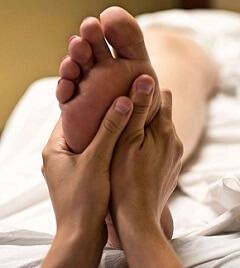
Massaging the affected area helps the muscles to relax, therefore reducing the symptoms of foot cramps.
Massage works by increasing the circulation to the muscles, thereby increasing the blood flow, oxygen and nutrient levels as well as taking away harmful waste products such as lactic acid.
You can reduce calf muscle cramps by massaging the muscles on the back of the calf from the ankle to the knee, and reduce toe and foot arch cramps by massaging the ball of the foot.
There are various different foot cramp massager products on the market that you can use to massage your feet so that your hands don't have to do the hard work!
4. Appropriate Footwear
One of the simplest things you can do to reduce the risk of foot cramps is to think about what you are wearing on your feet. When exercising, make sure you are wearing suitable shoes that are comfortable, fit well and support your feet. You can also reduce foot and toe cramps by steering clear of high heels or shoes with a narrow toe box everyday – keep them for special occasions. If you have flat feet, wearing some orthotic insoles can help to correct your foot position and reduce the risk of foot cramps.
5. Toe Stretchers
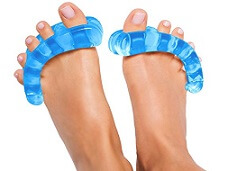
Toe stretchers are a hidden gem for people suffering from foot arch cramps or toe cramps. Many people find that wearing toe stretchers e.g. Yoga Toe for an hour or so each day reduces the frequency of foot cramps.
Toe stretchers help to stretch out the muscles and ligaments around the toes, and improve the alignment of the bones.
You can find out more loads more in the Toe Stretchers section and read user reviews - you'll be amazed at how much difference something so simple can make.
6. Increase Water Intake
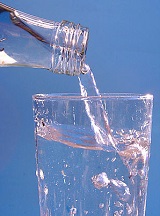
Another really simple way to reduce the occurrence of foot cramps is to drink more water. This helps prevent dehydration which is especially important in hot weather or if you are exercising lots to ensure the correct mineral balance.
You want to aim to drink between 3-4 liters of fluids a day, which equates to around 6-8 cups.
7. Balanced Diet
Eating the wrong things can increase your risk of developing calf, foot and toe cramps. Eating a healthy, balanced diet helps ensure a correct balance of vitamins and minerals to allow proper functioning of nerves and muscles. Cramp due to poor diet can be rectified in just a few days.
8. Exercise Appropriately
Whilst it is important to exercise regularly, exercising too much or too vigorously can increase the risk of foot and calf cramps. Always warm up and cool down before and after exercise. If you are new to exercise, start slowly and gradually build up the intensity so as not to overload your body. If sitting for long periods, keep your feet moving by circling your ankles to improve circulation to your feet.
9. Strengthening Exercises
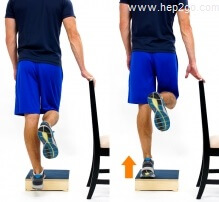
Improving the strength of the foot muscle can reduce the chances of toe cramps e.g. practice picking up marbles with your toes. You can reduce the risk of calf muscle cramps by repeatedly rising up on your tip toes to strengthen your calf muscles.
Visit the Calf Workout section for a whole range of exercises to strengthen the calf muscles and reduce the risk of developing foot cramps.
10. Supplements
Blood tests may indicate a deficiency of some vitamins and/or minerals in which case taking supplements can help, such as magnesium. Always check with your doctor before taking any supplements, as they may have harmful side effects.
Can Leg Cramps Be A Sign Of Something Serious?
In most cases, foot cramps are not serious and are rarely a medical emergency. But sometimes, they can be a sign of an underlying medical condition which would need treatment. If you are experiencing regular cramps in your hands or feet, consult your doctor. It is really important to get an accurate diagnosis.
If you are having other problems with your foot as well, visit the foot pain diagnosis section for help working out what may be causing your problem and what you can do about it.
Foot Cramps Summary
Foot cramps are a common problem. You may get leg cramps, calf cramps, general foot cramping, foot arch cramps or toe cramps.
Foot cramps are involuntary spasms that can affect the muscles in your feet. Common causes are dehydration, low levels of electrolytes, overexercising, and prolonged sitting or standing. Common symptoms of muscle cramps include sudden sharp pain, localised tenderness, and swelling.
Treatment for foot cramps usually involves rest, gentle stretching, heat or ice application, lifestyle modification and drinking plenty of fluids.
You may also be interested in the following articles:
- Pain On Top Of Foot
- Pain On Bottom Of Foot
- Inner Foot Pain
- Outer Foot Pain
- Ball Of Foot Pain
- Nerve Pain In The Foot
- Swollen Feet & Ankles
- Foot Numbness
- Foot Lumps & Bumps
Related Articles
Page Last Updated: 01/18/24
Next Review Due: 01/18/26
References
